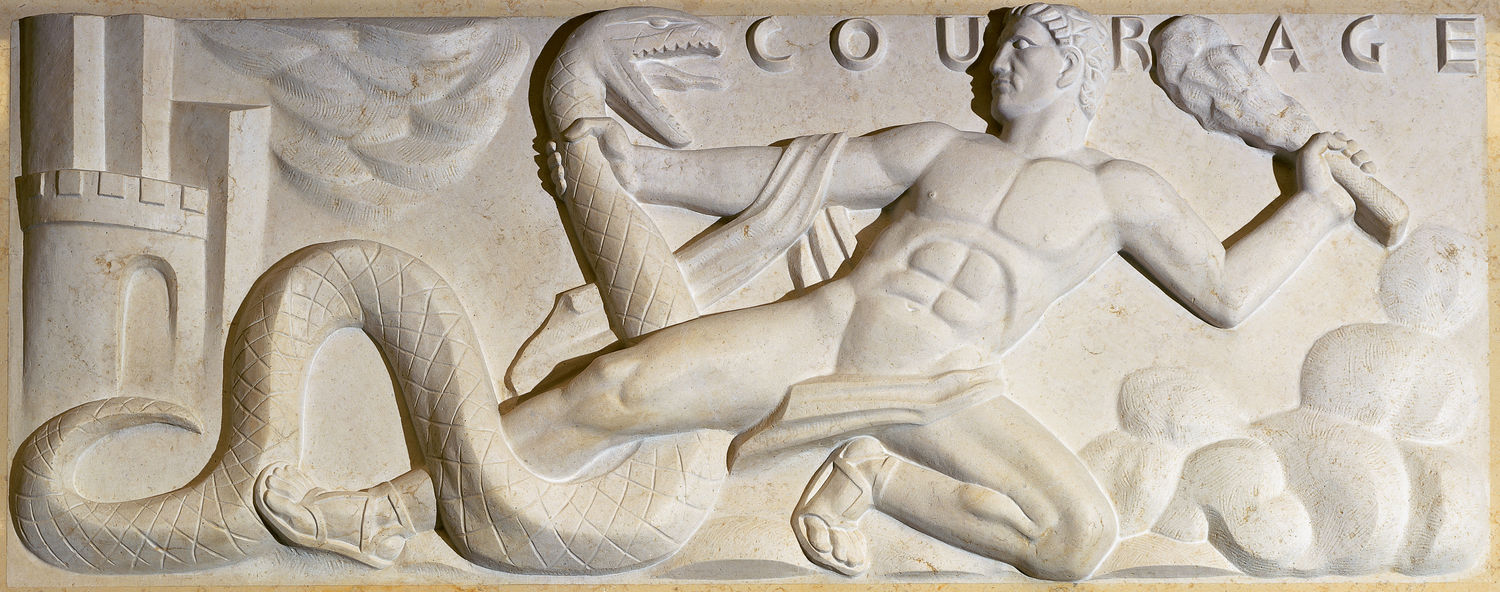
| Title | Courage |
| Artist/Maker | Lee Oscar Lawrie ( 1877 - 1963 ) |
| Date | 1950 |
| Medium | Marble |
| Dimensions | h. 33 x w. 68.5 in. (h. 83.8 x w. 174 cm) |
| Credit Line | U.S. Senate Collection |
| Accession Number | 25.00008.000 |
A November 1938 structural report on the condition of the roof over the north and south wings of the Capitol revealed major deficiencies and hazards, and recommended the complete removal of the ceilings in the Senate and House Chambers. In 1940 Congress approved funds to replace the roofs, and temporary ceiling supports were installed in the Chambers. Because of a shortage of materials and skilled labor during World War II, however, the work was delayed until 1949. By the time construction began on the Senate Chamber ceiling, a more sweeping remodeling scheme had been approved. It called for the Chamber’s elaborate mid-19th-century style, characterized as “Victorian,” to be replaced with an early Federal-period look.
New sculptural embellishments were recommended in the Report of the Commission of Fine Arts, 1944-1948, but the sculpture for the Senate Chamber was not laid out in detail. Thus Maryland sculptor Lee Lawrie, who was awarded a commission for panels to be mounted above the three entrance doors in the Chamber, was given latitude in his selection of subject matter. “I tried to illustrate the qualities Wisdom, Patriotism, and Courage in the designs,” he later wrote, explaining his choices. (See also Patriotism, and Wisdom). The pieces were carved in place by three different artists based on Lawrie’s plaster models. Bruno Mankowski of New York City sculpted the relief of Courage over the west entry.
Lawrie was born in Germany but moved to the United States shortly after his birth. A prolific sculptor, he was considered “Dean of American Architectural Sculpture.” The artist was responsible for the sculptural elements on most of the buildings designed by American architect Bertram G. Goodhue. In the 1955 American Sculptors Series, Lawrie was noted as “a sculptor who believes that architecture provides the most reasonable place for expressions of the sculptor’s art.” [1] Of Lawrie’s more than 300 commissions, ecclesiastical themes are most prominent.
Other works by the artist include sculptures located at the Bok Singing Tower in Lake Wales, Florida; the Chapel at West Point Military Academy in West Point, New York; the Nebraska State Capitol in Lincoln; St. Thomas Church in New York City; the Harkness Memorial Quadrangle at Yale University in New Haven, Connecticut; and the figure of Atlas in front of the International Building at Rockefeller Center in New York City.
The artist is well represented in Washington, D.C., where his works include bronze doors for the John Adams Building, Library of Congress; large relief panels for the National Academy of Sciences Building; the south entrance portal of the National Shrine of the Immaculate Conception; a memorial relief at The Octagon Museum; and a portrait of George Washington at the National Cathedral. In addition, Lawrie modeled eight classical panels that were cast in plaster for installation in the East Room of the White House, as part of the Theodore Roosevelt renovation of the house in 1902.
1. Joseph F. Morris, ed., Lee Lawrie, The American Sculptors Series, vol. 14 (Athens: University of Georgia Press, 1955), 7.